30 Amazing Facts About Hanukkah That’ll Make Your Holiday Bright

Each year, millions of Jews around the world gather with friends and family to celebrate Hanukkah, the Jewish Festival of Lights. The holiday has come to be associated with lighting candles, eating potato pancakes, and giving gifts. But what else do you know about Hanukkah? Sure, you probably know it lasts eight nights—but do you know why? From the origins of its name to out-of-this-world celebrations, read on to discover the most amazing facts about Hanukkah.
RELATED: 65 Fun Christmas Facts to Get You in the Holiday Spirit.
Why Do the Jewish People Recognize Hanukkah?

Before we get into things, let’s kick things off with a quick history lesson. To sum it up briefly, Hanukkah commemorates the Jewish military victory against the Syrian king Antiochus Epiphanes, during which one day’s worth of oil burned for eight nights.
This made it possible for the Jewish rebels, known as the Maccabees, to rededicate the Holy Temple in Jerusalem after its desecration by the Syrians. Of course, there is a whole lot more to the story than that, and even more to uncover about the tradition itself.
30 Hanukkah Facts That Might Surprise You
Below, we’ve put together a list of some little-known facts surrounding the Festival of Lights. Test your knowledge of the holiday by seeing which tidbits you recognize, and which ones you don’t.
1. Hanukkah has been celebrated in space.

Christmas isn’t the only winter holiday astronauts have brought with them to space. In 1993, while aboard the space shuttle Endeavor, astronaut Jeffrey Hoffman brought a menorah (the Hanukkah candle holder) and a dreidel (the holiday’s top), which he played on a televised broadcast in celebration of Hanukkah.
Hoffman—NASA’s first Jewish-American astronaut—also made history in 1985 when he brought a Torah (the Jewish holy book) into space for the first time.
2. Giving gifts on Hanukkah stems from Christmas.

While gifts are frequently exchanged on Hanukkah, Rabbi Dave Mason, author of The Age of Prophecy, says that doing so is a relatively modern practice.
“It’s a custom that started recently in predominantly Christian countries so the Jewish kids wouldn’t feel jealous of their Christian friends on Christmas,” he explains.
3. Hanukkah moves around on the calendar.

While you’ll find Christmas and other religious holidays on fixed dates on the Gregorian calendar, Hanukkah moves around from year to year. That’s because the holiday begins on the 25th of Kislev on the Jewish calendar.
As a reminder, a year on the Hebrew calendar varies from 353 to 385 days, which is why the holiday jumps from date to date in the fall and winter.
4. Hanukkah can start on any day of the week, except for a Tuesday.
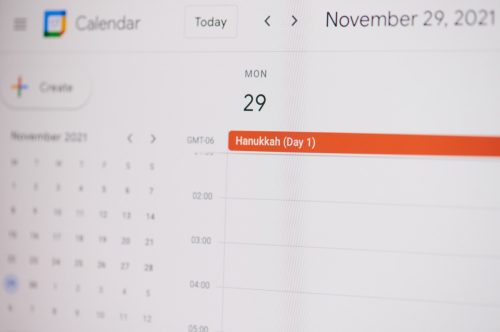
Some Jewish holidays, like Yom Kippur and Rosh Hashanah, can only fall on certain days of the week to avoid coinciding with the sabbath, Shabbat. However, Hanukkah has fewer limitations and can begin on any day of the week except for Tuesday, according to Chabad.
That’s due to the fact that the month before Kislev, Cheshvan, can have either 29 or 30 days.
5. Donuts are eaten on Hanukkah to recall the original miracle that the holiday commemorates.
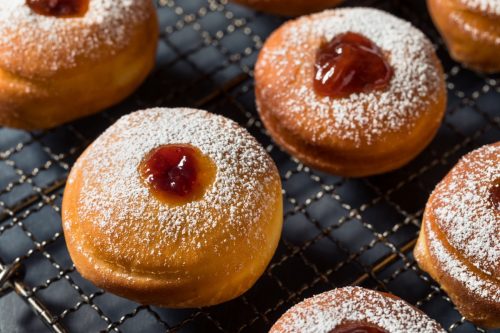
Ever wondered why jelly doughnuts, or sufganiyot, are traditionally served at Hanukkah? Mason explains that fried foods, like donuts, recall the original Hanukkah miracle of the oil burning for eight days.
6. As are latkes!

The same goes for potato pancakes, or latkes, which also fall into the mix of traditional Hanukkah foods.
“These are foods that are particularly saturated with oil, so they help us recall the miracle,” explains Mason.
7. Before latkes were made out of potatoes, they were made out of cheese.

According to Tori Ave, food blogger and founder of the popular blog The Shiksa in the Kitchen, the pancakes originally served during Hanukkah weren’t made out of potatoes—they were made out of cheese. The cheese once used in latkes was supposed to recall how Judith saved the Jewish people from Assyrian general Holofernes by first enticing him with a meal containing dairy, and ultimately beheading him.
RELATED: 15 Things You Should Know About Ramadan.
8. Latkes are a European invention—and a modern one, too.

According to the Encyclopedia of Jewish Food, for many years, upper-class Germans rejected the potato pancake, as potatoes were considered a lower-class food. It wasn’t until the 1840s that the tradition of potato latkes caught on—and only following a crop failure that lessened the availability of grain and made potatoes a more common food throughout Europe.
9. The holiday’s name is spelled in different ways because of a translation issue.

Have you ever wondered why you can spell Hanukkah in so many different ways?
Since the English language has no direct equivalent to the letter “chet,” with which the word Hanukkah begins in Hebrew, it’s commonly spelled both “Hanukkah” and “Chanukah” to reflect the Hebrew letter’s pronunciation.
10. The United States is home to the world’s largest menorah.
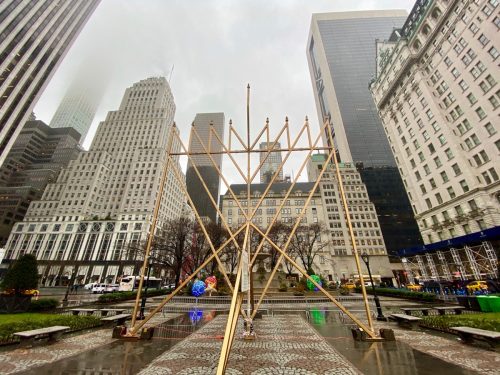
The biggest menorah in the world was built and lit in New York City at the corner of Fifth Avenue and 59th Street for Hanukkah in 2017. The giant menorah stood 36 feet tall and weighed a whopping 4,000 pounds. The city has continued to use the menorah to celebrate the holiday year after year.
11. The letters on the dreidel are an acronym.

The Hebrew letters on the dreidel—nun, gimmel, hay, and shin—actually represent more than just the rules of the traditional top-spinning Hanukkah game. In fact, they’re used as an acronym for “nes gadol hayah sham,” or “a great miracle happened there,” a Hebrew phrase used to describe the miracle of the oil’s staying power.
12. “I Have a Little Dreidel” was written by the brother of another famous Jewish composer.

The most famous English language Hanukkah song, “I Have a Little Dreidel,” was composed by Samuel E. Goldfarb, whose family has significantly changed modern Jewish music. His brother, Rabbi Israel Goldfarb, composed the melody for “Shalom Aleichem,” a traditional song sung on Shabbat.
13. The celebration of Hanukkah doesn’t appear in the Torah.
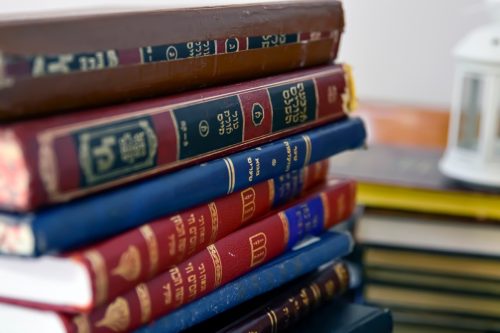
While you’ll find mentions of other Jewish holidays in the Torah, you won’t find Hanukkah in there. According to Chabad, the events that took place on the first Hanukkah occurred nearly 1,000 years after the Torah was written.
“It is a Rabbinic holiday,” explains Rabbi Shlomo Slatkin, MS, LCPC, a certified Imago therapist and co-founder of The Marriage Restoration Project. “While there are hints foreshadowing the holiday in Rabbinic literature, it is not Biblically ordained.”
14. The word “Hanukkah” means “inauguration.”
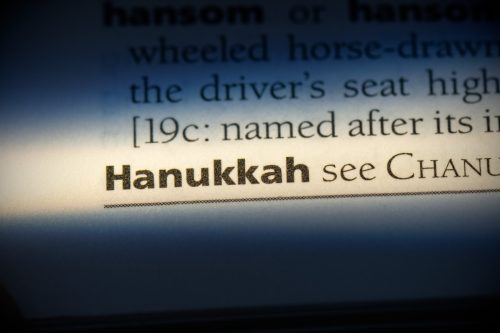
That said, a variation of the word “Chanukah” is found in the Book of Numbers. The phrase “chanukat hamizbeach,” or “dedication of the altar” appears in the story of Moses’ dedication of the Tabernacle—and, according to Chabad, the closest English translation of the Hebrew word is “inauguration.”
15. Some believe that Hanukkah is a belated celebration of another Jewish holiday.
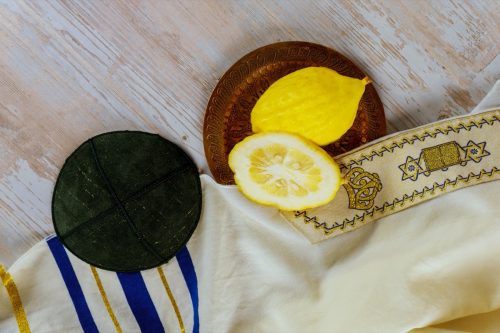
The eight nights of Hanukkah are thought by some to refer to another Jewish holiday that also lasts eight days. Some scholars believe that the holiday has eight nights because it was a belated celebration of Sukkot, which had to be postponed because of war.
RELATED: 35 Thanksgiving Facts to Share With Your Family.
16. Fasting is prohibited on Hanukkah.
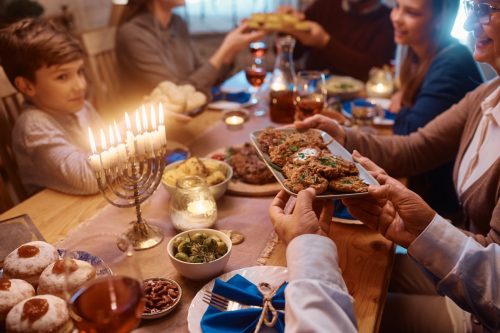
While fasting is traditionally done on Yom Kippur as a means of atonement, you don’t have to worry about forgoing those latkes on Hanukkah.
According to non-profit international yeshiva Ohr Somayach, fasting is actually forbidden during the eight days of Hanukkah.
17. But working is just fine.

Unlike Jewish high holidays like Yom Kippur and Rosh Hashanah, when many observant Jews stay home to attend temple services, there’s no such prohibition on working during Hanukkah.
18. The traditional Hanukkah lamp has different names, depending on where you’re from.

While, in the United States, it’s most commonly referred to as a menorah, the traditional Hanukkah candelabra is called different things depending on where your ancestors hail from.
“Jews of European descent (Ashkenazim) call their Hanukkah lamp a menorah,” explains Steven Fine, PhD, a professor of Jewish History at Yeshiva University in New York. However, among many Sephardic Jews in the Balkans and Holland, the lamp is traditionally referred to as a hanukkiah, or “Hanukkah lamp.”
19. Some rabbis believe the menorah’s light helps people see more clearly.

Lighting the menorah is a means of celebrating a miracle—and some rabbis believe that just looking at the light from the Hanukkah candles can have some pretty amazing results.
This light is thought to “[purify] our eyes so that we can see with a more elevated and G-dly perspective,” says Slatkin.
20. Some groups start with eight candles on the menorah.

While lighting one candle for each night of Hanukkah is traditional in many households, some start with the menorah fully lit.
“There was a debate between the two great Jewish academies about whether we should start with one candle and increase the number to eight, or if we should start with eight and decrease to one,” explains Mason.
According to those who observe the traditions of scholarly school Beit Shammai, the menorah should begin fully lit. For those who follow the tradition of Beit Hillel, the number of lights on the menorah increases as the holiday progresses, starting with one and ending with nine candles, including the shamash, the center candle that helps to light the others.
21. The menorah is typically lit at or after sundown.
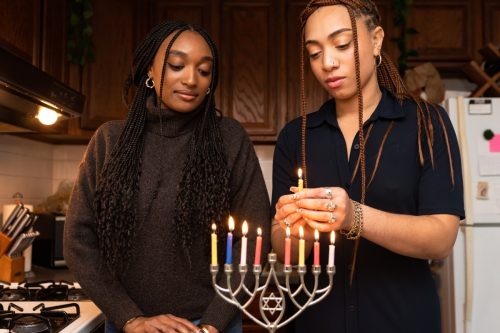
Don’t break out those Hanukkah candles first thing in the morning: Like most other Jewish holidays, the celebration begins at sundown. It’s then that most Hanukkah candles are lit—and they typically remain lit until they are naturally extinguished, rather than being blown out.
22. There’s a specific order for lighting the candles.

While candles are traditionally inserted into the menorah from right to left, that’s not the order they’re usually lit in. Instead, the candle representing the latest night of Hanukkah is lit first, meaning that the candles are lit from left to right instead.
23. Some rabbis believe that the menorah should be lit outside the home.

Think the menorah is just an indoor decoration? Think again!
“Hanukkah lights should ideally be lit just outside your door and should be lit at a time when people are on their way home for the evening,” Mason explains. This allows others to enjoy them.
24. Some versions of the Hanukkah story don’t mention the menorah at all.

While the menorah has become an integral part of many Jews’ Hanukkah celebrations, it’s not universally acknowledged as part of the festivities.
“Some early sources that retell the Hanukkah story only tell about the military victory and don’t mention the menorah at all,” explains Mason.
25. In many places, candles are so important to the holiday that borrowing money to get them is encouraged.

Lighting the menorah isn’t just a suggestion on Hanukkah—it’s an obligation. According to Ohr Somayach, the lighting of Hanukkah candles is so integral to the holiday that communities have an obligation to help those who cannot afford candles to get a set of their own.
RELATED: 30 Facts About Halloween No One Ever Told You.
26. But other homes don’t use candles to celebrate Hanukkah at all!

Though lighting candles has become a common practice at Hanukkah in many Jewish households, some rabbis see doing so as problematic. “Candles are permitted, but are less than ideal,” says Mason.
Instead, to keep in line with the origins of the Hanukkah story, Mason says that using a wick in olive oil is “the ideal way to light.”
27. The shamash serves a practical purpose outside the menorah.

Hanukkah candles aren’t supposed to be used outside of the menorah, but the shamash can be. In fact, in case of an emergency, the shamash can be used to provide necessary light, according to Rabbi Menachem Posner of Chabad.
28. Nobody knows who invented gelt.

While gelt—chocolate coins in gold foil—are part of countless Hanukkah celebrations, their origin remains unclear.
According to ReformJudaism.org, some believe that the tradition of giving gelt is supposed to reflect the gold coins people used to give rabbis during Hanukkah for the education they provided during the holiday.
29. And it wasn’t always just for children.

However, giving gelt to children is a relatively modern practice. The resource also reports that gelt became a gift for little ones starting in the 19th century.
30. The eighth night of Hanukkah is considered a final judgment.

While many people think of Hanukkah as a lesser holiday in terms of religious significance, it’s also a final opportunity for many observant Jews to earn redemption.
“Although we commonly think of Yom Kippur as the final seal of judgment, Jewish mystical works say that one has until the last night of Hanukkah to return to G-d and change his/her ways,” explains Slatkin.
Wrapping Up
That’s it for our list of Hanukkah facts, but be sure to check back with us soon for more fun facts! You can also sign up for our newsletter so you don’t miss out!